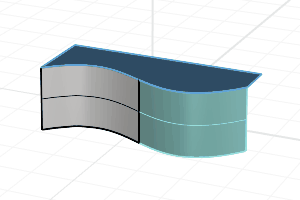Join
The Join command connects objects together to form a single object.
Join turns lines into polylines, curves into polycurves, surfaces and polysurfaces into polysurfaces or solids.
Join objects
Steps:
- Select an object (curve, surface, polysurface, or mesh).
- Select the next object.
- When you are finished selecting objects to join, press Enter.
 Join surfaces into polysurfaces.
Join surfaces into polysurfaces.
Command-line options
Undo
The Undo option removes the last selected object from the join operation.
Notes
- Join does not change the surfaces. It is merely a test to see if the surfaces edges are within 2x tolerance. If they are, then they are tagged as joined and not available for further joining.
- You can join curves that touch end-to-end.
- The order the objects are selected determines the layer of the new joined object.
- You can join surfaces and polysurfaces that touch at naked edges.
- Joining does not change the underlying surface geometry. It simply "glues" adjacent objects together so meshing, Boolean operations, and intersections can cross seams without gaps.
- To change a surface's geometry so it fills in a gap, use MatchSrf or fill the gap with a new surface created by FilletSr, NetworkSrf, or Patch.
- To change two adjacent surfaces into a single surface, use MergeSrf. Pay special attention to the setting of the Smooth option to get the geometry you want.
- Degrees and control points will not change when curves with different degrees are joined.
 left click
left click